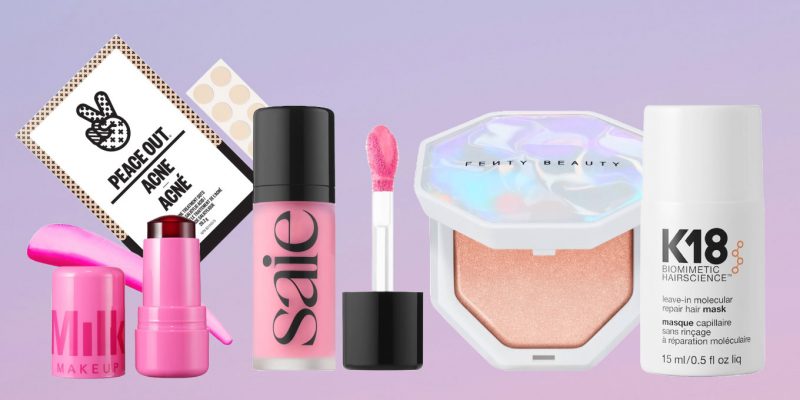Skincare
New FDA Study Finds Chemical Sunscreens Enter Bloodstream, But Don't Panic
There's no reason to stop wearing sunscreen.
by : Wing Sze Tang- Feb 5th, 2020

Getty
“Wear sunscreen” is the beauty equivalent of “Drink water”: advice you’ve heard so many times before, it’s practically a cliché. But if you caught the scary-sounding headlines about a recent sunscreen study by the U.S. Food and Drug Administration (FDA) – which found that some ingredients are able to absorb into the bloodstream after just a single use – you may be wondering if you should toss your bottle of SPF. (Spoiler: no.) Here’s what you need to know about the latest research.
What does this new FDA study on sunscreen absorption actually say?
Before getting into that, let’s backtrack a little. The latest FDA research, published in January 2020, is a follow-up to a May 2019 pilot study; both were published in the Journal of the American Medical Association. That earlier study was an “exploratory maximal usage trial” (MUsT), which is a standard way of figuring out the absorption of drugs into the body.
Basically, scientists wanted to know what would happen if sunscreens were slathered on generously and frequently (i.e. under “maximal-use conditions”): How much would be absorbed into the system? So, participants put on a lot – 2 mg of sunscreen per square cm, covering 75 percent of their body’s surface area, four times per day for four days.
Four different products, containing four chemical sunscreen filters (avobenzone, oxybenzone, octocrylene, ecamsule), were tested in the May study. All of these active ingredients managed to get into the bloodstream at levels surpassing 0.5 ng/mL (nanograms per millilitre). So, what’s the big deal about that threshold? That’s the level at which the FDA decides more safety testing is needed. What it doesn’t mean: that these ingredients have been proven unsafe.
The latest, hot-off-the-press FDA study analyzed four products, containing six chemical sunscreen filters (avobenzone, oxybenzone, octocrylene, homosalate, octisalate, octinoxate), and it looked at what would happen not only under maximal-use conditions (as in the first trial) but also after a single, full-body dose. The finding: All six active ingredients were absorbed in the bloodstream, and after just one use, all surpassed that 0.5 ng/mL threshold.
That sounds alarming. Isn’t it dangerous for sunscreen ingredients to absorb into my bloodstream?
Don’t leap to any conclusions – the FDA hasn’t. As the agency puts it, “The findings in these studies do not mean that the FDA has concluded that any of the ingredients tested are unsafe for use in sunscreens.” And the fact that it wants to do more testing doesn’t imply the ingredients are unsafe either; that’s the normal process for rigorously evaluating drugs and filling in data gaps.
“The research findings are not worrisome to me for several reasons,” says Dr. Monica Li, MD, a Vancouver-based medical and cosmetic dermatologist and a clinical instructor in the department of dermatology and science science at the University of British Columbia, who was not involved with the FDA studies. “First, the findings simply call for more research to better understand a universally important skin health product well-established for its public health benefits, such as reducing the risk of skin cancers and premature aging,” she explains.
Secondly, as both the FDA and Dr. Li point out, absorption does not equal risk. Finding out whether sunscreen ingredients getting into the body has any actual effect will require more research. But based on what we do know, the FDA pointedly says, there’s no reason to stop using sunscreen.
What does Health Canada say?
Health Canada regularly reviews information from FDA-led research and other sources, and it hasn’t changed its position on sunscreen safety after considering the new studies. What’s more, “Health Canada has no current plans to request additional safety data from sunscreen manufacturers,” says agency spokesperson Marie-Pier Burelle. “Health Canada continues to recommend the use of sunscreens in conjunction with other sun protective measures, such as protective clothing.”
Are there any sunscreen ingredients that don’t absorb into the bloodstream?
The FDA studies only looked at chemical sunscreen ingredients. But there are mineral sunscreen ingredients – zinc oxide and titanium dioxide – you can use instead if you’re worried about absorption. “Scientific evidence to date has not shown penetration of zinc oxide and titanium dioxide particles in mineral sunscreens through the skin surface,” says Dr. Li. “That’s why they are considered physical blocking agents, by sitting on the skin surface after application and acting as a physical barrier, reflecting away UV light.”
How about nano mineral sunscreens? Do they absorb into the bloodstream?
To avert the chalky cast of goopy mineral sunscreens past, some modern formulas are made with titanium dioxide and zinc oxide nanoparticles (smaller than 100 nanometres). “They are very effective at blocking ultraviolet radiation while not appearing ‘white’ after application on the skin,” says Dr. Li, noting that based on current evidence, these teeny-tiny nanoparticles still stay on the surface of intact skin.
What if I just don’t want to wear sunscreen?
The serious damage that freewheeling sun exposure does to the skin is the one area that doesn’t need any more research: It’s a fact. If you shirk SPF, remember that sun safety encompasses other measures, too – like wearing protective clothing, seeking shade, and avoiding direct exposure during the midday hours when the UV Index is highest.
Just give me the tl;dr.
There’s no need to panic. Wear sunscreen.
Read more:
The Beauty Products We’re Coveting For February
What We’ve Been Taught About How to Wash Our Face Is All Wrong
Newsletter
Join our mailing list for the latest and biggest in fashion trends, beauty, culture and celebrity.
More from Skincare
Read Next

Beauty
The Best Met Gala Beauty Looks Of All Time
From Taylor Swift's 'Bleachella' era to Rihanna's iconic 2011 braids, meet the best beauty moments in Met Gala history.
by : Katie Withington- Apr 26th, 2024

Culture
Benny Blanco Says He Fell in Love With Selena Gomez Without ‘Even Noticing’ It
Allow Benny Blanco to tell the straight-from-a-rom-com story of how he realized his feelings for his girlfriend and longtime friend.
by : Alyssa Bailey- Apr 26th, 2024

Culture
This University Elevates Women to New Professional Heights
You shouldn’t have to pause your life to move forward in your career.
by : ELLE Canada- Apr 16th, 2024




